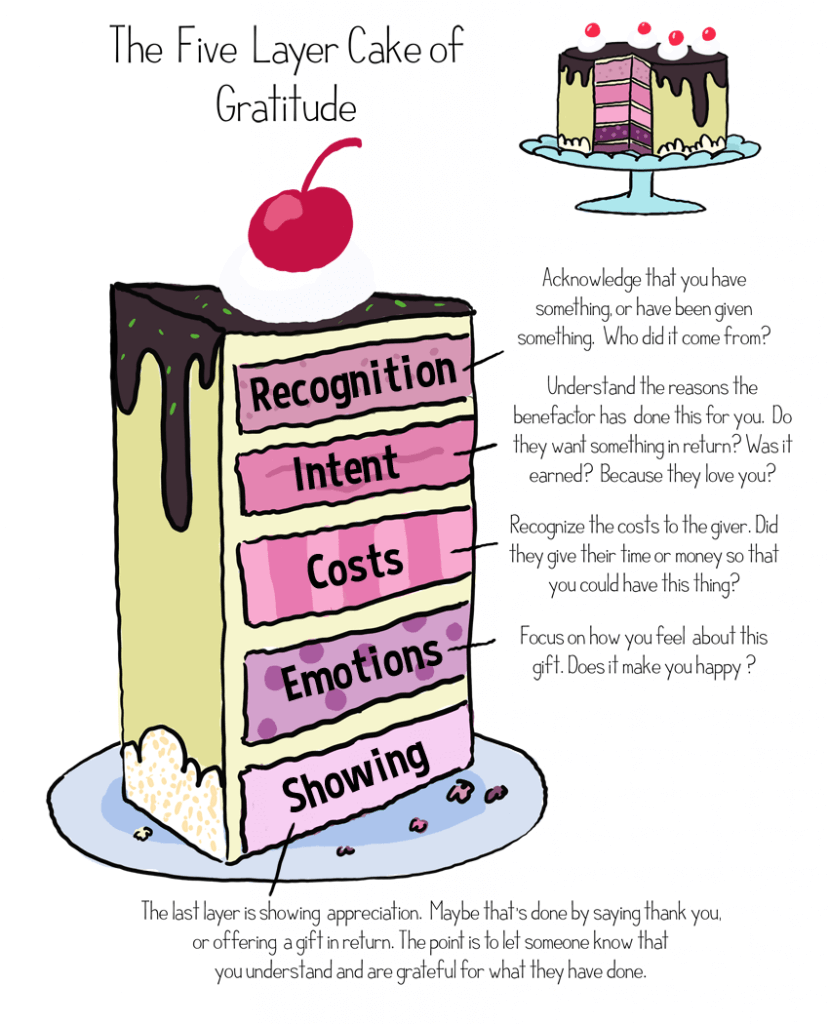Researchers agree that there are multiple layers to gratitude, components of it, though how many, and what they are, vary. Dr. Robert Emmons, a leader in gratitude research, defines gratitude as having just two parts: recognition and acknowledgment. Another study suggest three layers to gratitude. Yet another lists 32.
Regardless of how gratitude is broken down, most researchers agree there are certain layers that require an emotional maturity that young children just don’t yet have. Some layers call for empathy, which surfaces around age 2, but takes years to fully develop. Some layers require an understanding that other people are free-thinking, which doesn’t start to happen until age four or five. Emmons notes, “children younger than the age of 7 do not reliably understand that gratitude requires giving credit to others.”
That doesn’t mean we can’t still try to teach gratitude to our kids. We can start by thinking through a few of the most important layers. Let’s call it the RICES process.

The first layer is Emmons’ Recognition: seeing that you have something, or more specifically, that you’ve been given something. Was it a gift? Was it help? Was it affection? Where did that thing come from? Did I manufacture it on my own? Or was it given to me by someone else?
Next, try to understand the Intent of the benefactor. Why did that person do this for me? Do they want something in return? Did I earn it? Were they forced to give me this thing? Did they do it just because they wanted to? Because they love me?
Then, dive deeper. Try to recognize the Costs to the gift giver. Did they give their time or money so that I could have this thing? Were there other things they could have done with their time and money?
Now, the focus can turn to your own Emotions. How do I feel about this gift? Does it make me happy? Do I feel cared for? What is the benefit that I’ve been given? Am I better off now that I have this?
And finally, the last layer is Showing appreciation. Maybe it’s as simple as saying thank you, or as much as a reciprocated gift. The point is that you let someone know that you understand the previous components, and that you’re grateful for what they’ve done.
Giving Kids the Gift of Gratitude
Maybe the reason we rush to teach the last layer is that it’s the easiest for a child to do (if you can call getting them to remember something “easy”) and it hints at an understanding of the rest (which may or may not be true). However, if we also work to teach the first components, “thank you” may just come from their mouths more naturally, more genuinely, and not only when prompted, or as a matter of course at Thanksgiving dinner. Here are some ways we can help nurture genuine gratitude in our kids.
For younger kids, we can start the lesson by modeling it. Try talking through your own gratitude with them. Use the RICES process and say it out loud. If you receive a gift, show them you recognize it. Discuss who the gift came from, what the giver had to do in order to for you to have it. Tell them what it makes you feel, and what you’re going to do about it. This can be especially effective if it involves a gift from the child herself. Did she draw you a picture at school? Discuss with her why it feels so good for you to receive it. Let her know you understand their effort in making it.
We can also use RICES help them think through their own gratitude. When you see him receive a gift, or get help from someone, or receive affection, ask him some of the questions we listed above. Did you just get something new? Where did it come from? What had to happen for you to receive that? Why do you think you received it? Is it because you’re loved? Does that feel good? What should we do to show how you feel?
At the End of the Day…
Making someone grateful is hard. For kids, it just doesn’t come naturally. Believe me, I’ll continue teaching my kids to say thank you. I think it’s polite. It’s often expected. And manors will take them far in their lives. But I don’t want it to be a frustrating experience for them, or for me. So I’ll work harder to make sure that “thank you” doesn’t feel like one of their chores, that it comes out naturally as the final layer of genuine gratitude, as the S in RICES, and that they grow to be truly appreciative of everything they have in their lives, whether a holiday demands it or not.
References
- Emmons, R. A. (2007). THANKS: How the New Science of Gratitude Can Make You Happier. New York City: Houghton Mifflin Company